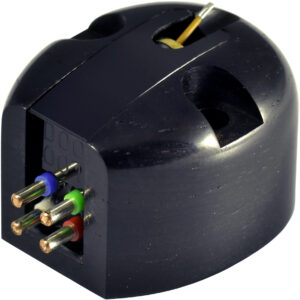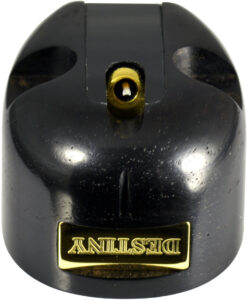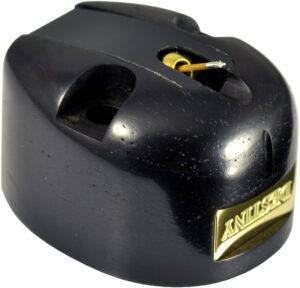Turntables, tonearms and cartridges used in assessing the full potential of the Destiny included the AMG 12J2 and Glanz MH-1200S tonearms on the Clearaudio Master Innovation turntable system, and the Oracle Sumiko 345 tonearm on the Kyocera PLA-910 turntable. Electronics included Pass Laboratories Xs Phono and their Xs Preamp, the Bricasti Design M28 monoblocks alternating with the Pass Labs XA200.8 monoblocks, the Sound Lab Majestic 645 electrostatic panels, and a system of Audio Reference Technology Analyst SE and EVO cables. The Stealth Audio Cables Helios was the reference phono cable.
The Destiny’s short body makes tonearm and headshell choices easy, whereas designs such as the Soundsmith Paua II with its long body mandate longer headshells to accommodate the output pins. Mounting holes are drilled into the bodyof the Destiny, but unlike those in the Top Wing and Soundsmith, they are not threaded, so nuts are still needed. Its specified 2.5 grams tracking force is a little on the heavy side, but I find heavier settings on most cartridges prevail in most instances anyway. All of the company’s stereo cartridges are rated at 9 µm, while the SabotenL and Shilabe are at 8 µm, requiring a higher mass tonearm for a more balanced spectrum distribution.
The AMG 12J2 tonearm came with a choice of two counterweights, only one of which will fit at any given time. In coupling with the Miyajima, the lighter counterweight had to be positioned near the outer edge of the arm to provide adequate counterbalancing. In any case, the heavier counterweight provided superior tracking and richer tone. Though specified with a 250 Ohms resistive loading, with a highly versatile and supremely differentiating, powerfully phono stage such as the Pass Laboratories Xs Phono, the Miyajima found its most exemplary partner in extensions and separation at 500 Ohms. Less powerful phono stages may need to open up more at lower-impedance settings.
The 1983 Deutsche Grammophon release of a digital recording of the Richard Strauss strings epic Metamorphoses – Study for 23 solo strings is more three-dimensional and dynamic and has a higher degree of immediacy than the label’s 1977 analog recording of the same work by the same ensemble and conductor. The earlier recording, however, presents an arguably more spacious sounding experience, and an even more dramatic and spontaneous performance. In contrast, the $17k Top Wing Suzaku separates the two recordings effortlessly and judiciously, delivering differentiation not heard from lesser cartridges. While the Miyajima does not differentiate to the same level, the differences between the recordings are nonetheless laid bare.
The tympanic roll at the end of the first movement of the 1977 Tchaikovsky Manfred Symphony LP from the same label (DG 2530877) had solid tonal and transient definition. The Miyajima was able to sustain the massive waves of mid-bass energy, whereas all auditioned lower priced cartridges faltered to various degrees. The tolling of the bell in the third movement came across as well formed, superbly defined and pleasant to the ear. Upper range energy was mild. This conveyance of spatiality and reverberation sounded somewhat dormant, and violins, woodwinds and horns didn’t have the ear-opening shine and definition of the Top Wing Suzaku. Still, the rich lower- to upper-midrange via the Miyajima provided superb cues and sonic flavors that enticed me into long listening sessions. This is the last generation of pre-digital LP ever to emerge from DG, and while purely solid-state at this historic juncture, it wasn’t half bad.
The Miyajima also carried a sound less flagrantly intense than the $10,000 Koetsu Jade Platinum, but where it was less opulent, it presented an abundance of dynamic contrasts and tonal shading. The Miyajima is easily the equivalent of the Koetsu in detail retrieval and superior in dynamics, softer in textural renditions than the Top Wing, and with a shading infused with a nostalgically mild recession in the top-end. Plenty of cartridges are just weaker in tonality but the Miyajima is immensely immediate in tone while demonstrating refinement and individuality.
None of the cartridges I’ve auditioned carry the degree of smoothness of the Destiny. Instead of giving the feeling of breathing thrice-conditioned dry air, the Destiny brings a full and pristine upper midrange. Flutes, piccolos, horns and pianos no longer sound chalky as recreated by so many other cartridges; it was a glorious presence that I kept reliving again and again. Plenty of cartridges impart their own characteristics, making recordings sound all alike. The Destiny doesn’t homogenize recordings; instead, it retrieves the upper midrange like no one else’s business. It is a misty cartridge.
There is also an unmistakable care expressed in the design of the Miyajima, in how it makes instruments sound eminently full of differentiated flavors sans hints of artificiality. Misty. The 1968 “tulip” DG LP of Franz Schubert “Wanderer” Fantasy and Moments Musicaux by Wilhelm Kempff (DG 129372) is one of those LPs that demonstrates how analog solo piano recording techniques withstand the passage of time, and the Miyajima purveys it. More updated piano solo recordings, such as Horowitz At Home (DG 427772) from 1989, which sounds eerily like a 45rpm, flaunts the clarity of digital while the Miyajima, in no uncertain terms, extracts the ever-present deep tonality from the groove, reaffirming the artistry of both the performer and the recording technology used by the label.
To date, the top three best all-around performers in the cartridge category that I’ve auditioned and reviewed are the Top Wing Suzaku, the Van den Hul The Colibri XGW Master Signature, and the Miyajima Destiny.
The Miyajima Destiny harkens me back to the days when I was immersed in the 47 Laboratories Miyabi, not because it was the highest-performing cartridge but because it was the most well-rounded for less than five grand. Then the Miyabi was gone, and just like anything created by one artisan, it joined the category of one-offs. Retipping the 47 Lab by a third-party specialist forever altered the flavor. At the very least Mr. Miyajima has already had his son and daughter apprenticing under him. Succession is implied, continuity likely assured.
It doesn’t take much for me to feel happy initially with a product, and plenty of cartridges have made me happy upon initial auditioning. But the novelty wears out quickly and very few have the right stuff to stay around longer term. For quite a while during the Miyajima’s audition period, I consistently mistook it for another cartridge costing over $9,000, the review of which was scrapped since it kept reminding me of the Destiny.
The Miyajima reconstitutes orchestral instrument groups with gratifying dynamic contrasts, imparting spectacular separation along with distinct and proficiently defined tonalities that are presented unhurriedly. Where the Top Wing would scale the lows and the highs in breathtaking proficiency, stretch the extensions to the limits and amass complex tonality via its sophisticated construct, the Miyajima in the visually mesmerizing African Blackwood body honed a less complex structure and relayed a tone less dense, less vivid than the Top Wing but yielded one eminently sonorous and engaging. It is less precise though nearly as exacting as the Van den Hul and considerably more exacting than all others I have auditioned.
Despite the less differentiating demeanor, the Miyajima’s expert tonal separation, absent the Top Wing’s sparkling upper midrange, never prompted me to hurry back to the Top Wing. Decidedly, the Miyajima’s was not as extreme a design nor was that the goal of Noriyuki, but the cartridge’s suite of strengths and weaknesses constituted such beautiful balance, the beauty of the sum greatly outshone the parts.
The Miyajima Laboratory Destiny is a super cartridge for its asking price, and a very assuring one at that. Temptingly and unabashedly, the Miyajima shows me the great foundation on which it is built, and I continue to be mesmerized by its balanced sonic attributes. It is an excellent tracker, too, tracking piano solos alarmingly and similarly like the Top Wing through their most boisterous passages.
Times when I felt the cartridge is underpriced abounded. If the Top Wing did not exist, I would declare the Miyajima the crème de la crème of cartridges. One can spend more and get a more lush-sounding design, but the Miyajima’s differentiating finesse is a gem reminiscent of the very best.
I am very gratified that the Miyajima can sound this fine, indeed spectacular, with the $4,500 Oracle SME 345 and the $4,800 AMG 12J2 tonearms. I’ve auditioned cartridges for which the manufacturer’s representatives demanded they be installed on $9k+ tonearms. If you are using a sub-$5,000 phono stage, or even a sub-$2,000 phono stage, get the Miyajima first and enjoy the new sound, then upgrade your phono stage a year or two later.
The Miyajima Destiny is not a super high-tech expression of the cartridge building art, nor is it the ultimate expression of cartridge design; the Top Wing Suzaku remains at the top of the hierarchy, most notably in tonal richness, detail retrieval and dynamic contrast. The Van den Hul comes close with certain idiosyncrasies, such as a bare, long cantilever that may or may not be anyone’s favorite, and it sounded best when used with the companion The Grail SE phono stage for an additional $20,000.
Yet, the Miyajima is one of the smoothest sounding cartridges and has just enough dynamics to keep me wanting to re-experience it, despite having the Top Wing at hand. Next to the Top Wing Suzaku, the Miyajima is my best-value audio investment. Additionally, between the ultra-smooth $10,000 Koetsu Jade Platinum and the $12,000 Van den Hul The Colibri XGW Master Signature, the Miyajima Destiny does the most impressive balancing act and for a whole lot less. If you are looking to experience how good vinyl can get, the Miyajima Destiny may just be all the reference cartridge you’ll need for a very long time.
Review system:
PS Audio DirectStream Power Plant 20 AC regenerator
Acoustic Sciences Corporation TubeTraps
Audio Reference Technology Analysts EVO interconnects, power cable
Audio Reference Technology Analysts SE interconnects, power cables
Audio Reference Technology Super SE interconnects, power cables
Clearaudio Master Innovation turntable system with Smart 24 power supply
AMG 12J2 tonearm
Glanz MH-1200S tonearm
Kyocera PL-910 belt-drive turntable
Oracle SME 345 tonearm
Millennium record pluck
Stealth Audio Design Helios phono cable
Pass Laboratories Xs Phono
Pass Laboratories Xs Preamp
Pass Laboratories XA200.8 pure class A monoblocks
Bricasti Design M28 class A/AB monoblocks
Sound Lab Majestic 645 electrostatic panels
Copy editor: Dan Rubin
- ← Previous page
- (Page 2 of 2)




Constantine,
Thank you for this articulate and informative review. Could you comment on how the Destiny performed on the Glanz MH 1200s? Absolute and relative to the other tonearms?
Thanks, Geoff
Hello, Geoff,
Thank you for your inquiry and your readership. I thought the Glanz MH-1200S induced more powerful dynamic contrasting from the Miyajima Destiny, at the same time rendering a Koetsu Jade Platinum-like tonal vividness.
However, since I don’t have the Glanz MH-1200S anymore, I can’t make more updated and definitive comparison of its performance against other comparably priced tonearms.
Thanks Constantine. I have the Glanz MH-1200S and my experience agrees with yours on inducing powerful dynamics from a cartridge. Sometimes a bit too much. My Koetsu RSP loses a bit of its mellow nature. I will experiment with some headshells too as some users have reported better results using different head shells than the stock Glanz.
You’re very welcome, Geoff.
Also, I would suggest experimenting with different resistive loading, as well as cabling. The Glanz headshell is quite good.